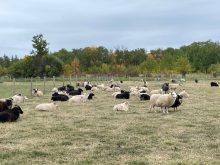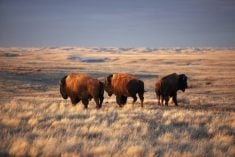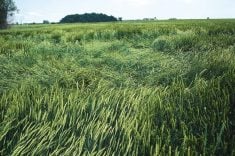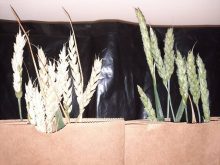When I undertook field research trials in Alberta in the 1970s on fungicides and insecticides for disease and insect control, I was often stymied by the Imperial (Canadian), U.S. and metric measurement systems. While the metric system was fairly straightforward and in its Canadian infancy, I had a hard time reconciling U.S. and Canadian measurement systems that persist, even today, after we are long converted to the metric system.
Weights and measures
Take for example, a pint of milk or a pint of beer. A Canadian pint is 20 ounces, an American (U.S.) pint is 16 ounces — no problem? In fact, a U.S. pint is 16.6 ounces, because a U.S. fluid ounce is four per cent bigger than a Canadian or Imperial ounce. A U.S. fluid ounce is 29.59 millilitres; a Canadian fluid ounce is 28.35 ml. So, when you buy a pint of U.S. milk or beer, you get about six ounces extra — that is, 16.6 ounces, not the 16 ounces you expected. It’s the same thing for gasoline or kerosene. The old Canadian (Imperial) gallon was 160 fluid ounces or 4.546 litres. A U.S. gallon is 128 fluid ounces at 29.59 ml and translates to 3.785 litres.
Read Also

Gentle treatments for pain in the neck
Heading toward year-end, people unknowingly tense up against the cold and busyness, causing neck pain that can often be treated with appropriate support and gentle mobility, athletic therapist Kathlyn Hossack says.
So, back in the 1970s, when I worked with pesticides, it was very confusing when we dealt with tiny amounts — were the fluid ounces in U.S. or Canadian ounces? So, before Canada became metric, we would often work in the metric system of millilitres and litres for real accuracy.
The metric system, though difficult for us old folks to adapt to, is not so confusing as the old Imperial system. In the old Imperial system, potatoes were weighed in hundredweight. A hundredweight was actually 112 pounds, since a ton was 2,240 lbs., exactly 20 hundredweight of 112 lbs., not 20 hundredweight of 100 pounds. Now we have a short ton, 2,000 lbs., an Imperial ton of 2,240 lbs. and a metric tonne of 2204.62 lbs.
When I grew up on the Welsh farm, chickens were weighed in pounds, people in stones (14 lbs. to a stone), pigs in scores (20 lbs. to a score) and cows in hundredweight (cwt). You really needed your mathematics in those days.
About 20 years back, I bought each of my three daughters a Canadian one-ounce gold maple dollar for Christmas. The coins were 99 per cent pure gold. I did some digging on gold currency and found out each one-ounce gold coin actually weighed one-and-one-10th ounce. You see, gold, platinum and silver are measured in the Troy weight system. A Troy ounce weighs 31.103 grams. A regular ounce weighs 28.38 grams. So, you can say that an ounce of gold (or silver or platinum) weighs more than an ounce of feathers.
On the other hand, there are only 12 Troy ounces to a Troy pound, which weighs out at 373.24 ounces. A regular pound is 16 ounces and weighs in at 453.59 ounces. So, you can also tell your friends that a pound of feathers weighs more than a pound of gold — good fun over a cup of social coffee to get your bets and win over your friends.

The weirdness of weather
Another fact of Prairie living is that we frequently see frost during the spring and even summer months. You check your truck or car windshield and it’s all frosted up. You might think that your plants froze. Not so; often frost can form at up to +5 C on plants or windshields, if the air is humid and the nights are cool, and your garden or crop plants did not freeze. Besides, many crop seedlings such as peas or canola can take up to -3 to -5 C.
For adult crop plants, though, even -1 to -2 C will cause considerable damage. Where I live, south of Spruce Grove, I have seen frost damage on beans as late as July 11 and as early as Aug. 12 on podded peas. Frost at -2 C will kill headed-out immature wheat, barley, oat and canola in the field, even though seedlings of these crops can stand up to -3 to -5 C.
READ MORE: Time to assess crops for frost, water damage
Thunderstorms not only bring rain but also fix nitrogen. Those lightning bolts will form nitric oxide and nitrogen dioxide, which quickly form nitric acid when it hits the ground. A good couple of inches from a thunderstorm can leave five to 10 lbs. of nitrogen per acre. That’s why an overgrazed, underfertilized pasture looks so refreshed a week or so after a good storm. Worldwide, lightning storms contribute about seven per cent of the world’s nitrogen fixation.
What is a chinook? A chinook is a wind front of warm air that descends on the Prairies on cold freezing winter days. Chinooks can raise the temperatures in a city such as Calgary from below freezing in December to 15 C or more above freezing in a matter of hours. Chinooks happen when moist warm air from the Pacific climbs over the Rocky Mountains. At many thousands of feet (metres) above the Rockies, the warm moist air condenses and forms snow. When that warm moist air forms snow, it then becomes cold dry air. Cold dry air is heavier than warm moist air and as it falls from tens of thousands of feet (metres) onto the Prairies it heats up through friction. This warm dry air, when it moves down a valley of pine or spruce trees, can cause severe dehydration on the trees, which lose moisture and turn brown. This happens because the soil is frozen, and the trees are unable to replace the moisture lost to the warm dry chinook wind. So, chinooks can be destructive on coniferous forests.
In most winters, pond and lake ice on the Prairies is thick enough to walk on and even to take vehicle traffic. You can go ice fishing in deep ponds and the fish you catch are not frozen. The water just under the ice is at 0 C; the water much deeper in the pond is at +4.4 C (40 F). That’s because water is heaviest when it’s at +4.4 C and sinks to the bottom of the pond or lake. So, when you are freezing at an ice fishing hole, the fish are at a “cozy” +4.4 C (40 F), down in the pond.
Frozen pipes? This one got me until I finally figured it out. Why are winter pipes placed at eight feet (almost 2½ metres) deep? It seems that when the soil freezes the ice is only a few inches deep. So, what happens? When the Prairies thaw out in April and May, the moisture evaporation from the surface soils initiates a freezing zone to move down the soil profile. In southern Ontario this freeze depth may only be 1½ feet (45.7 cm) but in the northern Prairies it can be as deep as eight feet. This is why water or sewage pipes freeze if they are not buried deep enough in Prairie Canada. Nature can be very confusing to most, if not all of us.
















